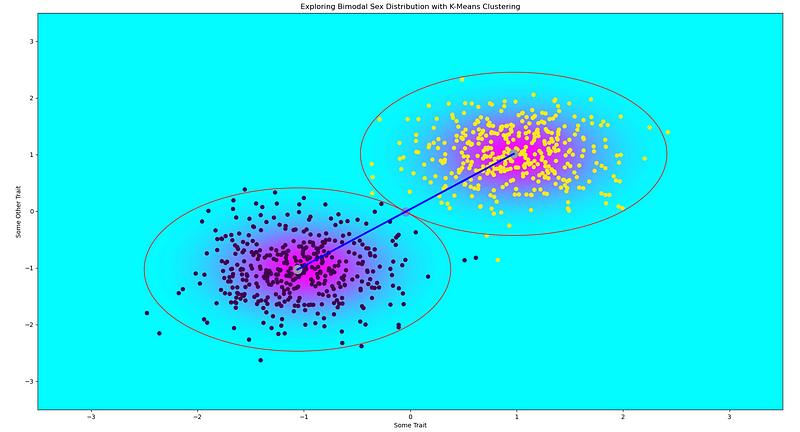Exploring the Bimodal Nature of Sex and Its Implications
Written on
Chapter 1: Understanding Bimodal Distribution in Sex
When we refer to sex as being “bimodally distributed,” what does that actually mean?

The complexities of language can be quite challenging. It's not just that writing can be tough; words can be vague, and everyone interprets them differently. This is why a significant effort is invested in defining terms in academic and formal discussions.
A contemporary topic of discussion has focused on the definition of sex, its connection to gender, and the number of recognized sexes. In previous writings, I provided a succinct definition of sex as: “a collection of reproductive-related traits that co-occur within a population.” While this definition is straightforward, it may lack depth without further elaboration.
Basic Concepts
Clustering — This concept involves identifying subgroups within a dataset. Members of a cluster share more similarities than differences or exhibit a common characteristic.
For example, elements within a cluster may resemble each other more than they differ. Alternatively, they may all exist within a specific property range.
Centroids — A centroid generalizes the idea of a “center” or “average.” It can be illustrated by the arithmetic mean of a series of numbers or the center of mass for a solid object.
Distribution of Reproductive Traits
Reproductive traits vary widely, encompassing aspects like height, hormone levels, and gamete production. The fusion of gametes is fundamental to human reproduction. Evolutionary biology highlights the importance of having two distinct gamete types.
These traits can be visualized as points in an n-dimensional space, with each population represented by a set of these points. Evolutionary pressures favor the existence of two differentiated gametes, leading to two clusters in most species, including humans.
To categorize these data points, various clustering techniques can be employed. For numerical datasets, k-means clustering is one option. However, reproductive traits often involve categorical data, necessitating approaches like k-modes clustering or more specifically, k-prototypes.
Deciding Partitions

The illustration above depicts a set of 2-dimensional points created by combining two sets of normally distributed data, each centered around distinct locations. We start with the premise of two primary clusters due to selective evolutionary pressures.
The radius for each cluster is set to half the distance between the two centroids, ensuring the clusters remain exclusive. These clusters represent male and female individuals, with the centroids serving as average representations for each sex.
Why not use the entire clusters generated by k-means or k-modes algorithms? The plot shows that elements from the two clusters intermingle. Without overlap, there would be a clear boundary between the two groupings. However, overlap does occur, both in the simulated data and in actual human reproductive biology.
To construct a definition of sex, a precise measure is essential. Proponents of a binary view of sex argue that every individual fits neatly into one of two categories: male or female. The centroids symbolize the two sexes, with the male centroid reflecting sperm production and the female centroid representing egg production. Individuals outside these boundaries are classified as intersex.
The dataset was generated from two independent normal distributions, with each variable having a standard deviation of 0.5. One distribution centered around (-1, -1) and the other at (1, 1). As intended, the majority of points clustered within one of the two categories—49.375% in one cluster, 49.25% in the other, with only 1.375% falling outside either.
The contour map illustrates the probability density function (PDF) resulting from averaging the two normal distributions, thus creating a bimodal distribution. Notice how the distribution of points aligns with the contour map. While points stem from separate unimodal distributions, collectively they form a bimodal population.
3As: Assumptions, Adjustments, and Assessment
The previous model is a simplified representation. The points were derived from two normal distributions with different centers, guaranteeing two distinct clusters.
In reality, we can still expect two primary clusters, regardless of the presence of outliers. The hypothesis of two clusters of reproductive traits in humans is grounded in prevailing evolutionary theories.
The example model assumes equal variance for both clusters. However, even if variances differ, only the radius of the circles would change. With sufficiently low variance, two distinct clusters may emerge, encompassing all relevant points without overlap.
Under ideal conditions, a binary sex classification might be feasible. However, numerous case studies highlight variations in sexual development, indicating that achieving such low variance is improbable.
Additionally, the distribution of reproductive traits is perpetually evolving. This means that the representative centroids and the clustering regions are in constant flux, altering what defines male or female with each generation.
Thus, even if we could accurately approximate the partitions of sex, they would only be valid for a specific moment. Changes in an individual’s traits can shift the distribution, even slightly.
Summary
A range of biological traits related to reproduction exist, placing the reproductive characteristics of populations in a highly dimensional space. Some traits are quantitative, while others are qualitative.
Based on evolutionary theory, we anticipate that the distribution of individuals will cluster into two primary groups. Each cluster features a representative mode that reflects the most common arrangement of traits, specifically reproductive traits.
The mode related to sperm production represents the average male population, while the egg production mode signifies the average female population. Individuals outside these clusters do not neatly fit into either category.
To maintain distinct clusters, their radii must be restricted. Only under very ideal circumstances will all individuals fit within one of the clusters, and even then, it applies only at a specific moment. The ongoing evolutionary shifts mean that the clusters and their centroids are continuously changing.
This scenario supports the assertion that sex is bimodal. If all individuals were to fall exclusively within the radii of the two clusters, then sex would be strictly binary. However, such conditions do not persist due to the constant evolutionary changes within the population.
Recognizing that sex is not binary compels us to move beyond rigid classifications. We must acknowledge the extensive variability in human sexual development, a recognition that extends to areas such as sports.
Redefining Sports Divisions for a Modern Era
It's time to eliminate sex and gender-based distinctions and focus solely on individual capabilities.
The first video, "How to Have the BEST SEX of Your Life," explores strategies for enhancing sexual experiences, providing insights into achieving fulfillment in intimate relationships.
The second video, "Mike Tyson [EXPLICIT]: How To Have Sex While In Prison," features candid conversations about navigating intimacy under unusual circumstances.